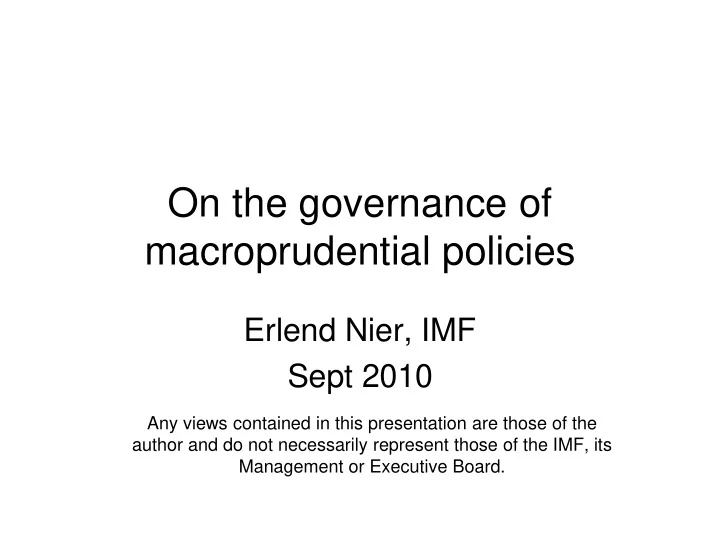

On the governance of macroprudential policies Erlend Nier, IMF Sept 2010 Any views contained in this presentation are those of the author and do not necessarily represent those of the IMF, its Management or Executive Board.
Overview: what’s needed? • Clarity of objectives and understanding of tasks and perimeters • Challenge: dynamic system requires powers – information, designation calibration • Ensure powers used effectively: – Strong legal mandate – Congruence between mandate and powers – Independence and accountability.
Prudential policies – two objectives • “Microprudential”: Investor (consumer) protection – Safety and soundness of institution is means to ensure protection of those who have claims on financial institutions • When there is asymmetric information between issuers and buyers of such claims – e.g. depositors, holders of insurance claims and pensions • “Macroprudential”: Mitigation of systemic risk
Systemic risk - a definition • Disruption to the provision of financial services (credit) that risks having a material adverse effect on the real economy . (IMF, 2009) • Two dimensions 1. disruption from aggregate weakness 2. disruption from individual failure
Systemic risk externalities • Externalities – from aggregate weakness • exacerbated by expectations of support (too many to fail) – from individual failure • exacerbated by expectations of support (too important to fail) • create a rationale for intervention that is distinct from consumer protection – just as monetary and financial stability are distinct • one is insufficient to secure the other • can be well aligned, but also conflict
Macroprudential regulation – three tasks – reduce probability and impact of aggregate weakness by applying countercyclical measures • Complementing monetary policy – reduce impact of individual failure by discouraging excessive exposures between financial institutions • Complementing oversight of clearing and settlement – reduce probability of individual failure by applying surcharges that are sensitive to systemic risk posed • Complementing resolution tools
Perimeters of regulation Financial Services Providers Leveraged providers Systemically of credit important
Perimeters of regulation • Countercyclical measures: – all leveraged providers of credit , since their weakness collectively poses systemic risk • Measures to reduce exposures (impact): – between all leveraged providers of credit and systemically important institutions • Systemic surcharges (probability): – all systemically important institutions as a function of externality posed
Basic challenge - dynamic system requires powers • Financial sector evolves - continuously and sometimes fast - to exploit profitable opportunities. • Set of collectively systemic institutions can change • Set of individually systemic institutions can change • Level of systemic risk can change – both at aggregate and at individual levels • Macroprudential regulation needs to respond flexibly; requires powers.
Information collection powers • Assessment of the financial sector as a whole is needed. • Requires the power to collect information from all financial services providers – e.g. on exposures, business models, levels of leverage – preferably directly from firms (e.g. U.S. OFR) • alternatively from supervisors, commercial data warehouses
Designation powers • All individually systemic institutions need to be brought into scope (e.g. of surcharges) • irrespective of legal form and based on predefined criteria (e.g. interconnectedness, substitutability) • All collectively systemic institutions need to be within scope, (e.g. of countercyclical measures) • irrespective of legal form and including non-banks: – GSEs?, investment banks?, money market mutual funds?
Calibration powers • Efficiency : stringency of macroprudential requirements function both of – level of systemic risk • can vary across time and sectors – implications for the cost of financial services • Rules need to be complemented by judgment , taking in all information.
Strong legal mandate • Mandate needs to open up and constrain discretionary use of powers , by defining objectives: – Primary objective: safeguarding systemic stability – Secondary objectives, e.g.: – have regard to the need to maintain a level of financial services conducive to economic growth – have regard to interest of stakeholders (depositors) - in case of conflicts
Aligning mandate and powers • Whoever has mandate needs to have the tools (powers) • Obvious? Not always heeded pre-crisis (post crisis?) • If macroprudential regulator is not the microprudential supervisor: – it needs to have control over (some power to direct ) actions of micro-supervisor • e.g. hierarchical (subsidiary) structure planned in UK
Independence and accountability • Independence: to fortify the regulator against lobbying and political interference • Accountability: to guard against incompetence and abuses of power – mechanisms need to maintain distance to political process , e.g. can require • communication of decisions and reasons to the public • annual report to parliament • a periodic review of the framework
International cooperation • International minimum standards can serve as useful benchmarks, but – may be insufficiently tailored to local conditions – yet encourage complacency • May need to be complemented by – comprehensive guidance – active national frameworks – regional cooperation • e.g. ESRB in Europe
Role of central banks • Central banks can bring expertise and incentives; should have strong role – if macroprudential policies ineffective, central banks • need to do more “leaning” (second -best) • need to do more “cleaning” (third -best) • But: need different governance for monetary and macroprudential policy – UK: central bank governor chairs Financial stability committee
References • Acharya and Yorulmazer (2007): Too Many to Fail - An Analysis of Time- inconsistency in Bank Closure Policies, Journal of Financial Intermediation, 16, pp. 1 – 31. • Brunnermeier et al (2009) The Fundamental Principles of Financial Regulation, Geneva Reports on the World Economy, 11, CEPR. • Cihak and Nier (2009): The need for special resolution regimes for financial institutions, IMF WP • Crocket (2000): Marrying the micro- and macro-prudential dimensions of financial stability • HM Treasury (2010) : A new approach to financial regulation: judgment, focus and stability • IMF (2010): Central Banking Lessons from the Crisis • IMF et al (2009) : Guidance to Assess the Systemic Importance of Financial Institutions, Markets and Instruments: Initial Considerations • Nier (2009) : Financial Stability Frameworks and the Role of Central Banks, IMF WP
Recommend
More recommend